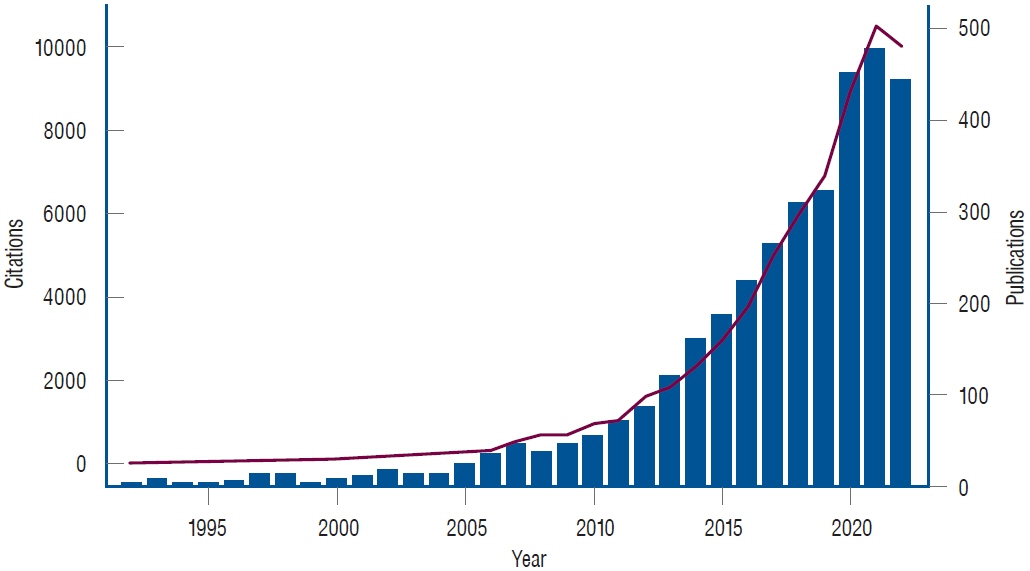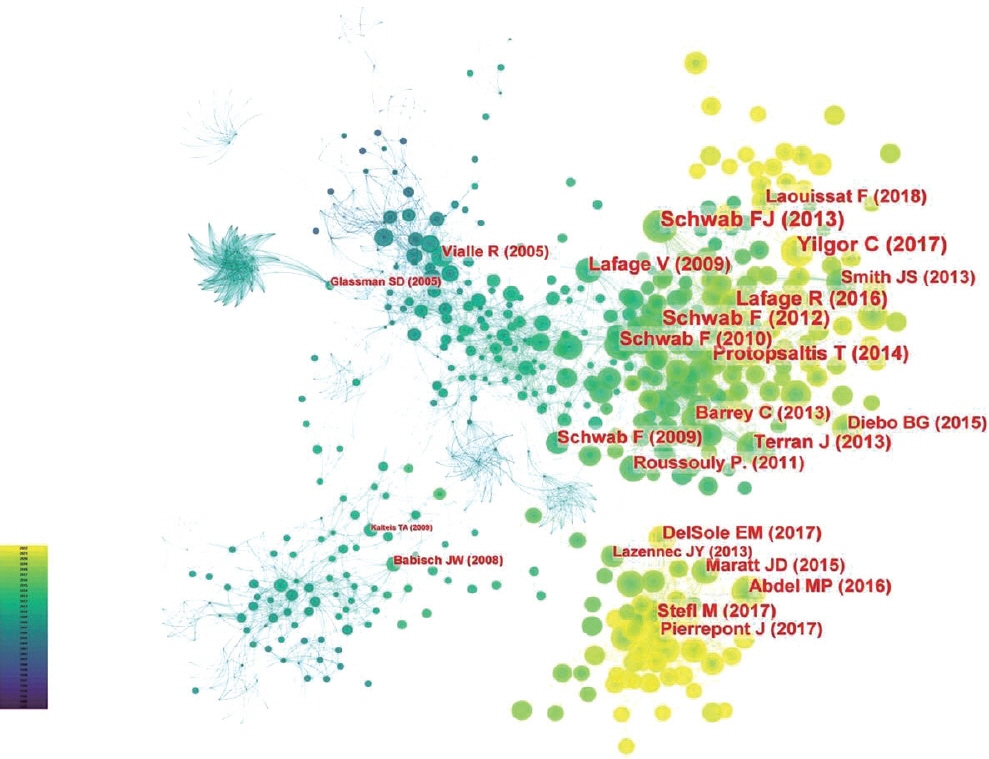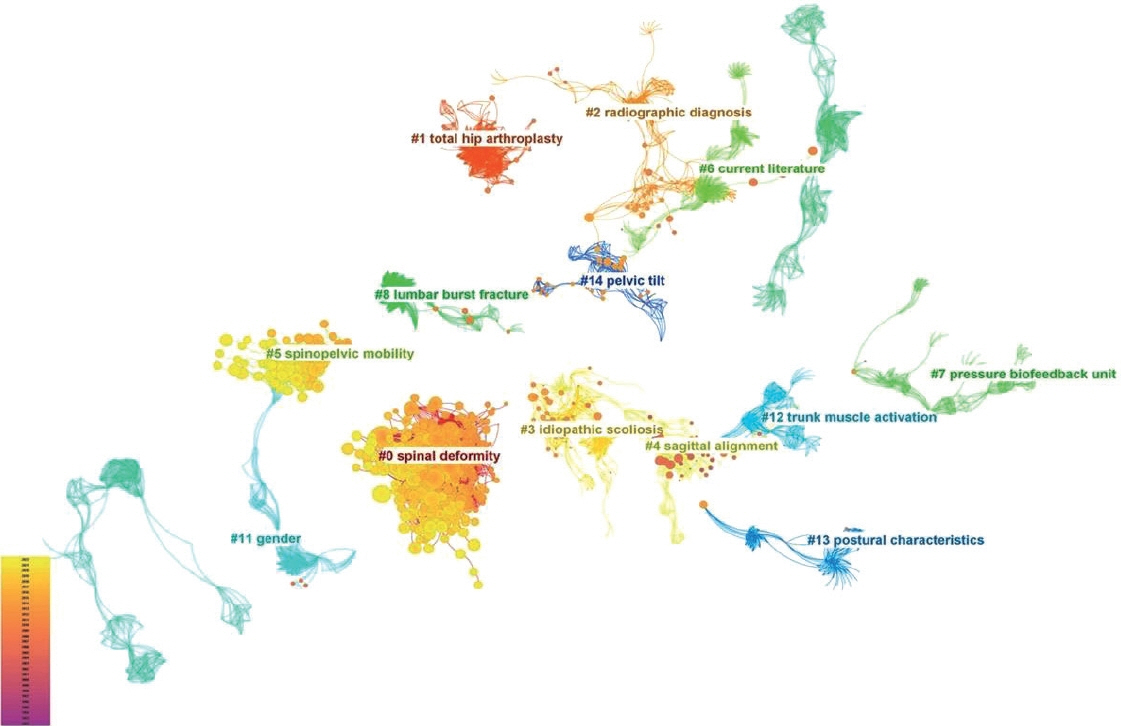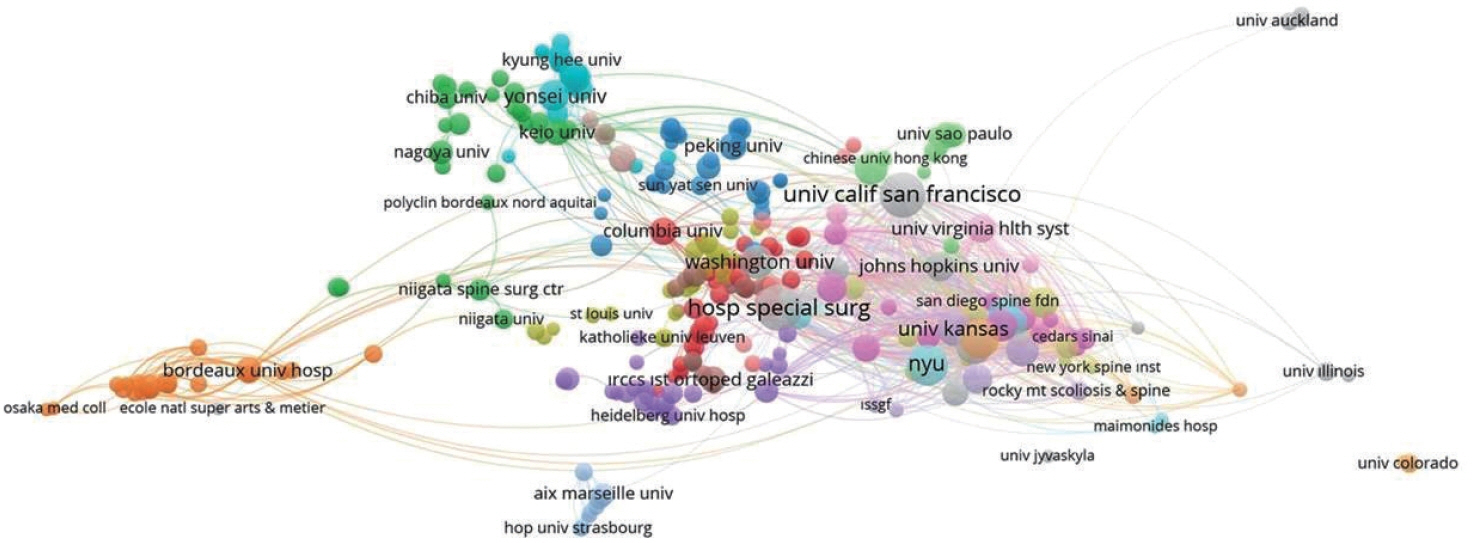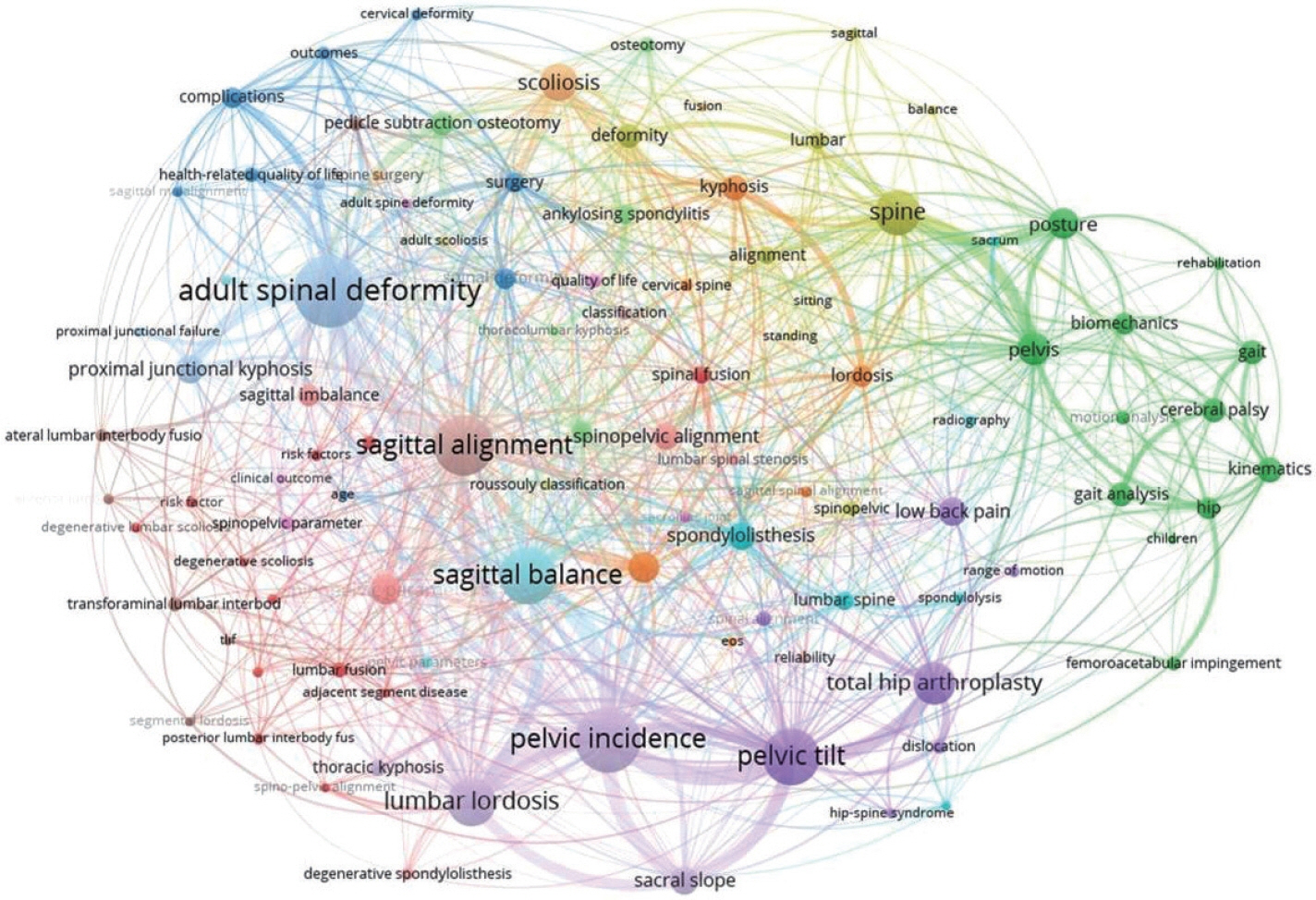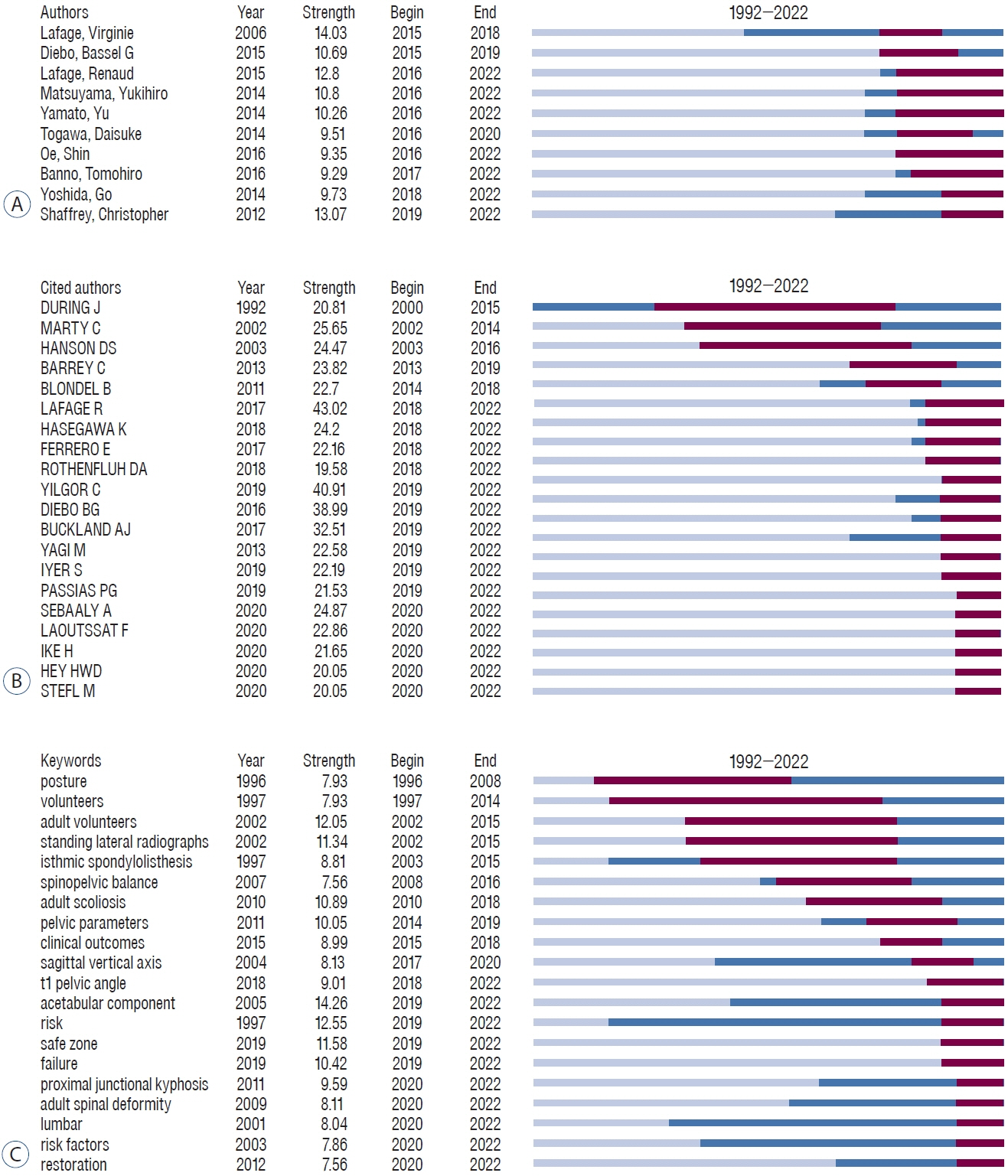J Korean Neurosurg Soc.
2024 Jan;67(1):50-59. 10.3340/jkns.2023.0047.
Publication Trends in the Pelvic Parameter Related Literature between 1992 and 2022 : A Bibliometric Review
- Affiliations
-
- 1Istanbul Physical Treatment and Rehabilitation Training and Research Hospital, Istanbul, Turkey
- 2SBU Bagcilar Training and Research Hospital, Istanbul, Turkey
- KMID: 2550459
- DOI: http://doi.org/10.3340/jkns.2023.0047
Abstract
Objective
: This study aimed to conduct a bibliometric analysis on pelvic parameter related research over the last 30 years, analyzing trends, hotspots, and influential works within this field.
Methods
: A comprehensive Web of Science database search was performed. The search yielded 3249 results, focusing on articles and reviews published from 1992 to 2022 in English. Data was analyzed using CiteSpace and VOSviewer for keyword, authorship, and citation burst analysis, co-citation analysis, and clustering.
Results
: The number of publications and citations related to pelvic parameters has increased exponentially over the last 30 years. The USA leads in publication count with 1003 articles. Top publishing journals include the European Spine Journal, Spine, and Journal of Neurosurgery: Spine, with significant contributions by Schwab, Lafage V, and Protoptaltis. The most influential articles were identified using centrality and sigma values, indicating their role as key articles within the field. Research hotspots included spinal deformity, total hip arthroplasty, and sagittal alignment.
Conclusion
: Interest in pelvic parameter related research has grown significantly over the last three decades, indicating its relevance in modern orthopedics. The most influential works within this field have contributed to our understanding of spinal deformity, pelvic incidence, and their relation to total hip arthroplasty. This study provides a comprehensive overview of the trends and influential research in the field of pelvic parameters.
Keyword
Figure
Reference
-
References
1. Berge C. Heterochronic processes in human evolution: an ontogenetic analysis of the hominid pelvis. Am J Phys Anthropol. 105:441–459. 1998.
Article2. Chen C. CiteSpace II: detecting and visualizing emerging trends and transient patterns in scientific literature. JASIST. 57:359–377. 2006.
Article3. Glassman SD, Bridwell K, Dimar JR, Horton W, Berven S, Schwab F. The impact of positive sagittal balance in adult spinal deformity. Spine (Phila Pa 1976). 30:2024–2029. 2005.
Article4. Król A, Polak M, Szczygieł E, Wójcik P, Gleb K. Relationship between mechanical factors and pelvic tilt in adults with and without low back pain. J Back Musculoskelet Rehabil. 30:699–705. 2017.
Article5. Lafage R, Ferrero E, Henry JK, Challier V, Diebo B, Liabaud B, et al. Validation of a new computer-assisted tool to measure spino-pelvic parameters. Spine J. 15:2493–2502. 2015.
Article6. Lafage V, Schwab F, Patel A, Hawkinson N, Farcy JP. Pelvic tilt and truncal inclination: two key radiographic parameters in the setting of adults with spinal deformity. Spine (Phila Pa 1976). 34:E599–E606. 2009.7. Lafage V, Schwab F, Vira S, Patel A, Ungar B, Farcy JP. Spino-pelvic parameters after surgery can be predicted: a preliminary formula and validation of standing alignment. Spine (Phila Pa 1976). 36:1037–1045. 2011.8. Le Huec JC, Aunoble S, Philippe L, Nicolas P. Pelvic parameters: origin and significance. Eur Spine J. 20(Suppl 5):564–571. 2011.
Article9. Le Huec JC, Faundez A, Dominguez D, Hoffmeyer P, Aunoble S. Evidence showing the relationship between sagittal balance and clinical outcomes in surgical treatment of degenerative spinal diseases: a literature review. Int Orthop. 39:87–95. 2015.
Article10. Legaye J, Duval-Beaupère G. Sagittal plane alignment of the spine and gravity: a radiological and clinical evaluation. Acta Orthop Belg. 71:213–220. 2005.11. Legaye J, Duval-Beaupère G, Hecquet J, Marty C. Pelvic incidence: a fundamental pelvic parameter for three-dimensional regulation of spinal sagittal curves. Eur Spine J. 7:99–103. 1998.
Article12. Lim JK, Kim SM. Difference of sagittal spinopelvic alignments between degenerative spondylolisthesis and isthmic spondylolisthesis. J Korean Neurosurg Soc. 53:96–101. 2013.
Article13. Makhni MC, Shillingford JN, Laratta JL, Hyun SJ, Kim YJ. Restoration of sagittal balance in spinal deformity surgery. J Korean Neurosurg Soc. 61:167–179. 2018.
Article14. Protopsaltis T, Schwab F, Bronsard N, Smith JS, Klineberg E, Mundis G, et al. The T1 pelvic angle, a novel radiographic measure of global sagittal deformity, accounts for both spinal inclination and pelvic tilt and correlates with health-related quality of life. J Bone Joint Surg Am. 96:1631–1640. 2014.
Article15. Roussouly P, Gollogly S, Noseda O, Berthonnaud E, Dimnet J. The vertical projection of the sum of the ground reactive forces of a standing patient is not the same as the C7 plumb line: a radiographic study of the sagittal alignment of 153 asymptomatic volunteers. Spine (Phila Pa 1976). 31:E320–E325. 2006.16. Schwab FJ, Blondel B, Bess S, Hostin R, Shaffrey CI, Smith JS, et al. Radiographical spinopelvic parameters and disability in the setting of adult spinal deformity: a prospective multicenter analysis. Spine (Phila Pa 1976). 38:E803–E812. 2013.17. Schwab F, Lafage V, Boyce R, Skalli W, Farcy JP. Gravity line analysis in adult volunteers: age-related correlation with spinal parameters, pelvic parameters, and foot position. Spine (Phila Pa 1976). 31:E959–E967. 2006.18. Schwab F, Patel A, Ungar B, Farcy JP, Lafage V. Adult spinal deformitypostoperative standing imbalance: how much can you tolerate? An overview of key parameters in assessing alignment and planning corrective surgery. Spine (Phila Pa 1976). 35:2224–2231. 2010.19. Sullivan TB, Marino N, Reighard FG, Newton PO. Relationship between lumbar lordosis and pelvic incidence in the adolescent patient: normal cohort analysis and literature comparison. Spine deform. 6:529–536. 2018.
Article20. van Eck NJ, Waltman L. Software survey: VOSviewer, a computer program for bibliometric mapping. Scientometrics. 84:523–538. 2010.
Article21. Van Royen BJ, Toussaint HM, Kingma I, Bot SD, Caspers M, Harlaar J, et al. Accuracy of the sagittal vertical axis in a standing lateral radiograph as a measurement of balance in spinal deformities. Eur Spine J. 7:408–412. 1998.
Article
- Full Text Links
- Actions
-
Cited
- CITED
-
- Close
- Share
- Similar articles
-
- Publication trends of somatic mutation and recombination tests research: a bibliometric analysis (1984‒2020)
- Publication Trends in Osteoporosis Treatment: A 20-Year Bibliometric Analysis
- The most influential articles on kidney transplantation: a bibliometric and visualized analysis
- Contemporary research trends on nanoparticles in endodontics: a bibliometric and scientometric analysis of the top 100 most-cited articles
- Basic Pelvic Parameters Associated with Lumbar Degenerative Disease: Review Article

